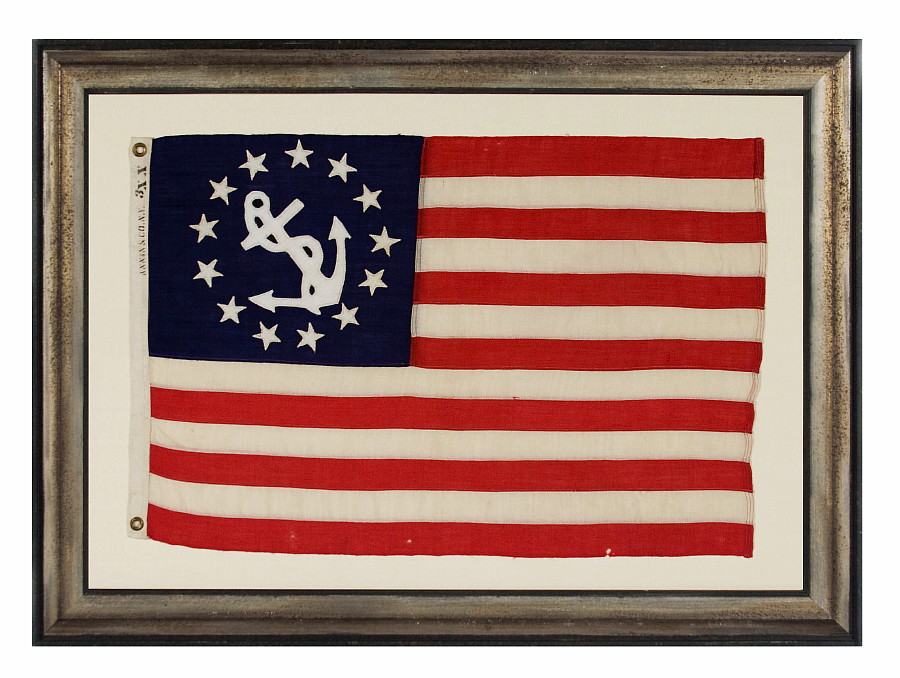
| |
13 STAR PRIVATE YACHT FLAG, A SCARCE AND DESIRABLE EXAMPLE WITH SINGLE-APPLIQUED, HAND-SEWN STARS AND ANCHOR, PROBABLY MADE BY ANNIN IN NEW YORK CITY, CA 1890-1910 |
|
| Available: |
Sold |
| Frame Size (H x L): |
35.25" x 47.5" |
| Flag Size (H x L): |
24.5" x 37" |
|
| Description....: |
|
13 STAR PRIVATE YACHT FLAG, A SCARCE AND DESIRABLE EXAMPLE WITH SINGLE-APPLIQUED, HAND-SEWN STARS AND ANCHOR, PROBABLY MADE BY ANNIN IN NEW YORK CITY, CA 1890-1910:
This private yacht ensign was probably made during the last decade of the 19th century, which makes it earlier than most of the examples in this form that surface in the antiques marketplace. The flag's most interesting and desirable trait lies in its hand-sewn stars and anchor, as well as in the manner in which they were applied. These elements are single-appliqued. This means that they were applied to one side of the canton, then the blue fabric was cut from behind each star, folded over, and under-hemmed, so that one appliqued star could be visible on both sides of the flag. While some flag enthusiasts have pointed to this construction method as a way of conserving fabric and cutting corners (i.e., not having to sew another star to the other side), others suggest that the real purpose was to make the flag lighter in weight. I believe it to be a function of both of these endeavors and I always find single-appliqued stars more intriguing for two reasons; one, because they are more visually interesting and two, because when executed properly they serve as evidence of a more difficult level of seam-work and stitchery.
The stars and anchor are made of cotton. The canton and stripes of the flag are made of wool bunting that has been joined with machine stitching. There is a heavy cotton hoist with two brass grommets. Though it is unsigned, the flag was probably made by the Annin Company in New York. Practically all of the 19th century Annin-made flags I have examined, as well as some examples made during the 1st decade of the 20th century, have had hand-sewn, single-appliqued stars. Annin seems to have used this method long after most flag makers had abandoned it, at least as late as 1910. In fact, few companies pursued this method of construction at all, which almost always results in stars that appear more homemade, less uniform in shape, and thus exhibit qualities that are desired among collectors.
The medallion configuration, 13-star, 13-stripe flag with a canted center anchor was entered into official use in 1848, following an act of Congress that made it the official signal for U.S. pleasure sailing vessels. The need for such a flag arose with the popularity of boating as a pastime for well-to-do Americans, and as a competitive sport, in addition to its longstanding utilitarian role as a vehicle of trade. In early America, all boats were subject to customs searches at every port. Without modern income tax, the federal government derived its revenues mostly from tariffs, so an accounting of foreign goods on ships was a critical venture. As yachting for pleasure became more prevalent, however, more and more time was spent searching boats that had no such inventory, wasting time for both customs officials and wealthy ship owners.
John Cox Stevens, a former president of the Jockey Club and future founder of the Union League Club, became the New York Yacht Club's Commodore upon its founding in 1845. In 1847 he approached the secretary of the treasury and suggested that something be done to streamline the customs process for non-trade vessels. In 1848 legislation passed Congress requiring registration of these boats, which could then fly the "American Yachting Signal" to bypass customs.
In the 1880's, the 1848 legislation was revoked for some reason, maybe because ships were regularly flying the flag without registration, yet use of the yachting signal persisted. Beginning around 1890, the owners of many private yachts also started to fly 13 star flags in various forms without an anchor, a practice that remained popular into the 1920's. The 13 star anchor design, however, never fell from use. Persisting throughout the twentieth century, the signal is still widely flown today.
13 star flags have been used throughout our Nation's history for a variety of purposes. In addition to their use on private yachts, the U.S. Navy used the 13 star count on small boats, both in the 18th century and through most or all of the 19th century, particularly the second half. The Navy's use of the 13 star flag ended in 1916 following an executive order written by President Woodrow Wilson. Among other uses, 13 star flags were carried by soldiers during the Mexican and Civil Wars, used at patriotic events, including Lafayette's visit in 1825-26, flown at the celebration of the Nation's centennial in 1876 and the sesquicentennial in 1926.
Mounting: The flag has been stitched to 100% silk organza on every seam and throughout the star field for support. The flag was hand-stitched to its background, which is 100% hemp fabric. The mount was placed in a black-painted, hand-gilded and distressed Italian molding. The front is U.V. protective acrylic.
Condition: There is minor mothing throughout. The overall condition is a 9.5-out-of-ten for a wool flag of this size and period. |
|
|
|
| Collector Level: |
Intermediate-Level Collectors and Special Gifts |
|
| Flag Type: |
Sewn flag |
|
| Star Count: |
13 |
|
| Earliest Date of Origin: |
1890 |
|
| Latest Date of Origin: |
1910 |
|
| State/Affiliation: |
13 Original Colonies |
|
| War Association: |
|
|
| Price: |
SOLD |
|
| |
Views: 4220 |
|
|
|

